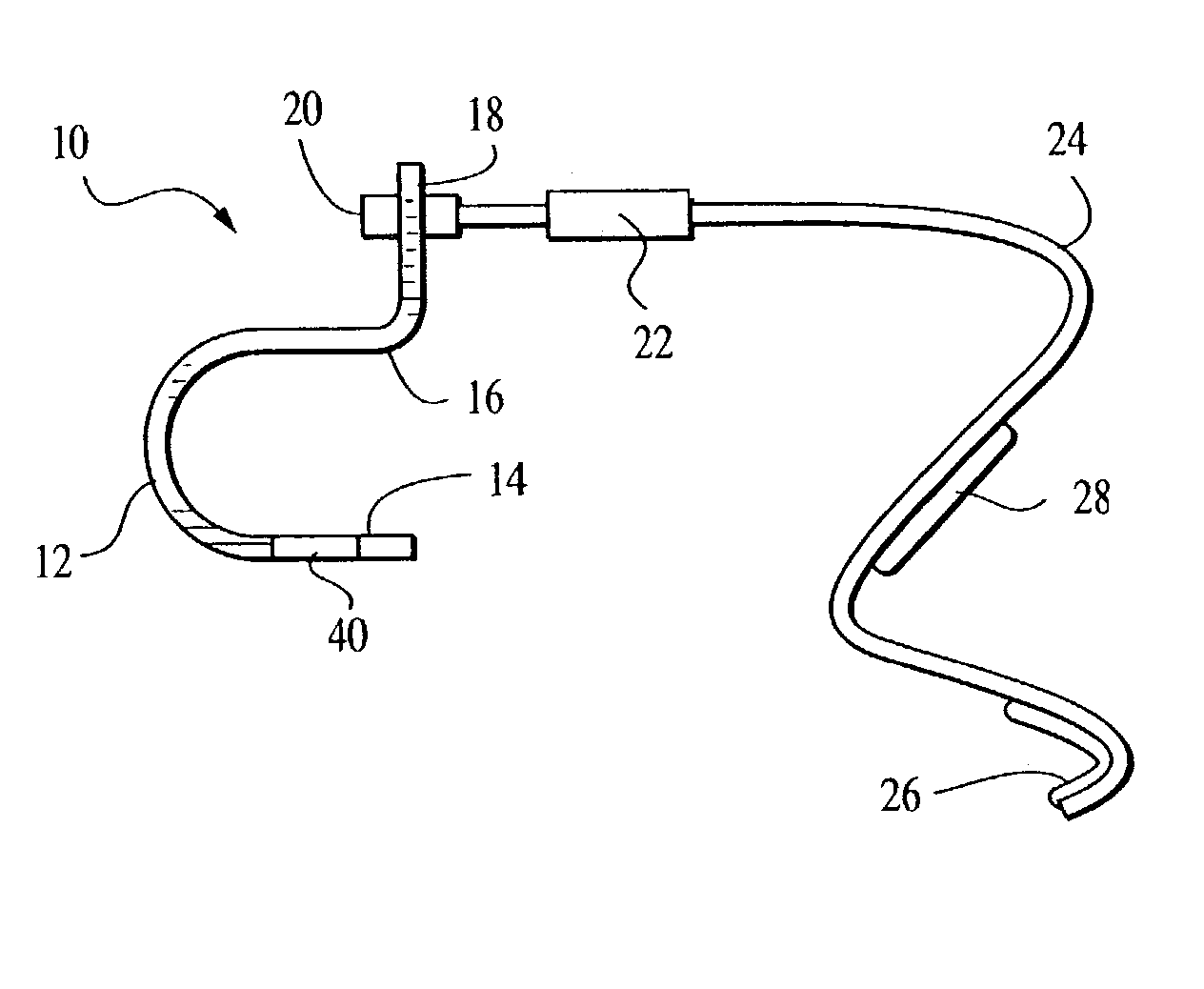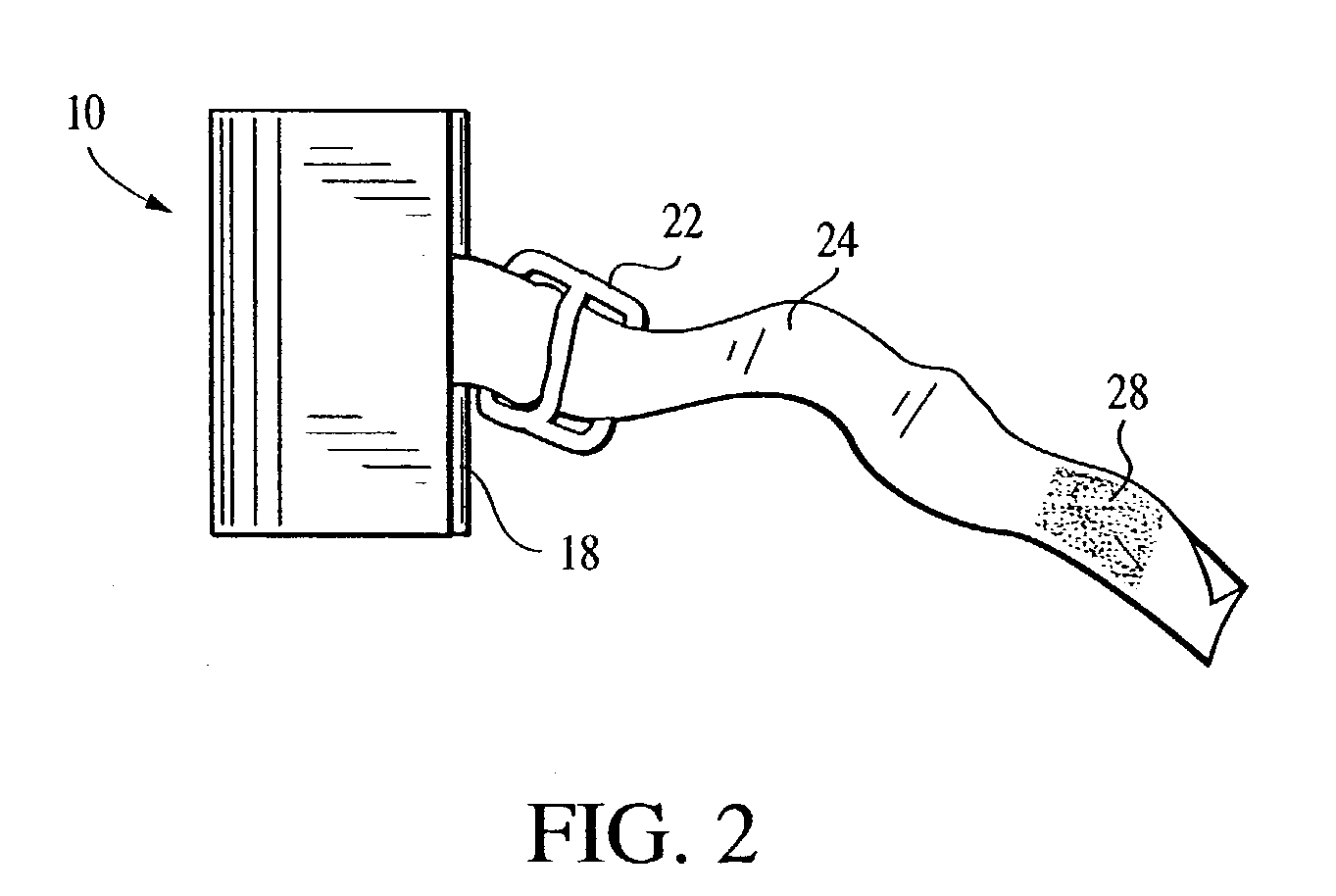Adjustable apparatus and method for treating carpal tunnel syndrome
a carpal tunnel syndrome and adjustable technology, applied in the field of carpal tunnel syndrome treatment, can solve the problems of inconvenient use, inability to adjust the device, etc., and achieve the effect of convenient use, simple and inexpensive manufacturing
- Summary
- Abstract
- Description
- Claims
- Application Information
AI Technical Summary
Benefits of technology
Problems solved by technology
Method used
Image
Examples
first embodiment
[0039]Referring now to FIGS. 1-2, an inventive apparatus 10 is shown. The apparatus 10 includes a housing 12 with a first support section 14 for retaining the hypothenar region of the hand, and a top edge 16 disposed generally along the longitudinal central dorsal portion of the hand. The housing 2 may be composed of a rigid material such as metal, hard plastic or wood, or a resilient material such as fiberglass or resilient plastic, or a combination thereof. Optionally, the housing 12 may include a plurality of ventilation openings (not shown) to provide ventilation to the patient's hand during the operation of the apparatus 10. A fulcrum 18 may be an upraised member substantially perpendicular to the dorsal region of the hand extending from or near the top edge 16. The fulcrum 18 may be a different, separate element from or near the housing 12, it may be an extension thereof, or it may be integral thereof. A flexible resilient strap 24 is attached to the fulcrum 18 via an attachm...
second embodiment
[0043]Referring now to FIG. 10, the apparatus 10 is shown as an apparatus 50. The apparatus 50 operates similarly to the apparatus 10, except that the fulcrum 18 is implemented as a pressure member 54 encompassing an edge 56 to improve patient's comfort. The apparatus 50 also includes an optional resilient lining 58 along the inner surface of a housing 52. The lining 58 may be composed of any resilient material including but not limited to: soft plastic, silicone gel, padding, foam, spring elements, and at least one fluid or air-filled bladder. Optionally, the lining 58 may be disposed only along a support section 60 rather than covering the entire interior of the housing 52. The strap 24 may optionally include a length adjustment device 22, such as a buckle. The strap 23 also includes optional releasable attachment connectors 26, 26, such as a hook and loop mechanism, a snap and the like (optionally only one such connector may be included).
third embodiment
[0044]Referring now to FIG. 11, the inventive apparatus is shown as an apparatus 100. The apparatus 100 includes a housing 102 with a first support section 104 for retaining the hypothenar region of the hand, and a top edge 106 disposed generally along the longitudinal central dorsal portion of the hand when the hand is inserted into the housing 102. The housing 102 may be composed of a rigid material such as metal, hard plastic or wood, or a resilient material such as fiberglass or resilient plastic, or a combination thereof. The housing 102 also includes a releasable connector 116 on its outer surface, such as a hook and loop mechanism, a snap or the like. The releasable connector 116 may be singular, or it may be split up into two or more separate pieces. A separate flexible resilient strap 108 is provided. The strap 108 may be composed of any resilient material such as nylon webbing, leather, rubber, or from any other synthetic or natural resilient flexible material. The strap 1...
PUM
 Login to View More
Login to View More Abstract
Description
Claims
Application Information
 Login to View More
Login to View More - R&D
- Intellectual Property
- Life Sciences
- Materials
- Tech Scout
- Unparalleled Data Quality
- Higher Quality Content
- 60% Fewer Hallucinations
Browse by: Latest US Patents, China's latest patents, Technical Efficacy Thesaurus, Application Domain, Technology Topic, Popular Technical Reports.
© 2025 PatSnap. All rights reserved.Legal|Privacy policy|Modern Slavery Act Transparency Statement|Sitemap|About US| Contact US: help@patsnap.com



